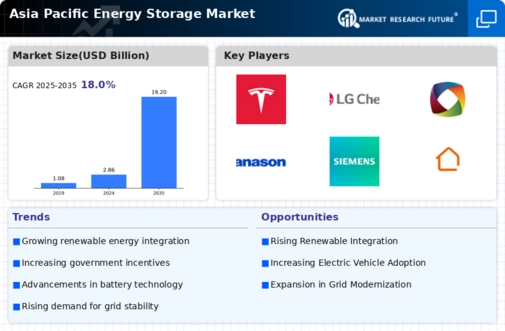Market Analysis
In-depth Analysis of Asia Pacific Energy Storage Market Industry Landscape
The Asia Pacific energy storage market has been experiencing significant growth in recent years, driven by a combination of various market factors that contribute to its expansion. One key factor is the region's increasing energy demand, fueled by rapid industrialization, urbanization, and population growth. As countries in the Asia Pacific region continue to develop, the demand for reliable and sustainable energy sources rises, creating a substantial market for energy storage solutions.
Government initiatives and policies play a crucial role in shaping the energy storage market in the Asia Pacific region. Many governments in the region are implementing supportive policies to encourage the adoption of renewable energy and energy storage technologies. These policies often include incentives, subsidies, and regulatory frameworks that promote the integration of energy storage systems into the existing power infrastructure. As a result, businesses and consumers are more inclined to invest in energy storage solutions, further propelling market growth.
The increasing penetration of renewable energy sources, such as solar and wind, is another significant market factor driving the demand for energy storage in the Asia Pacific. Renewable energy generation can be intermittent, and energy storage systems help address the challenge of variability by storing excess energy during periods of high generation and releasing it when demand is high or during periods of low renewable energy production. This capability enhances grid stability and reliability, making energy storage an integral component of the region's transition to a more sustainable and resilient energy landscape.
Technological advancements and innovations in energy storage technologies have also played a pivotal role in expanding the market in the Asia Pacific region. As the energy storage industry evolves, new and improved solutions are emerging, offering enhanced performance, efficiency, and cost-effectiveness. The availability of diverse energy storage options, including batteries, pumped hydro storage, and thermal storage, allows consumers to choose solutions that best fit their specific needs and requirements, contributing to the overall market expansion.
The electrification of transportation is yet another driving force behind the growth of the energy storage market in the Asia Pacific. The increasing adoption of electric vehicles (EVs) and the development of charging infrastructure necessitate robust energy storage systems to manage the demand for electricity and ensure a reliable and efficient charging network. As the EV market continues to gain momentum in the region, the demand for energy storage solutions to support this transition is expected to grow substantially.
Investments and collaborations within the energy storage sector also contribute significantly to the market's expansion. Both domestic and international investors are showing increasing interest in funding energy storage projects across the Asia Pacific region. Collaborations between governments, industry players, and research institutions foster a supportive ecosystem for innovation and development in the energy storage sector, further driving market growth.
Challenges such as high initial costs and concerns regarding environmental impact still exist, but ongoing research and development efforts are focused on overcoming these obstacles. As the Asia Pacific energy storage market continues to evolve, it presents immense opportunities for businesses, investors, and governments to contribute to a more sustainable and resilient energy future. With a confluence of factors propelling its growth, the energy storage market in the Asia Pacific is poised to play a pivotal role in shaping the region's energy landscape in the years to come.














Leave a Comment